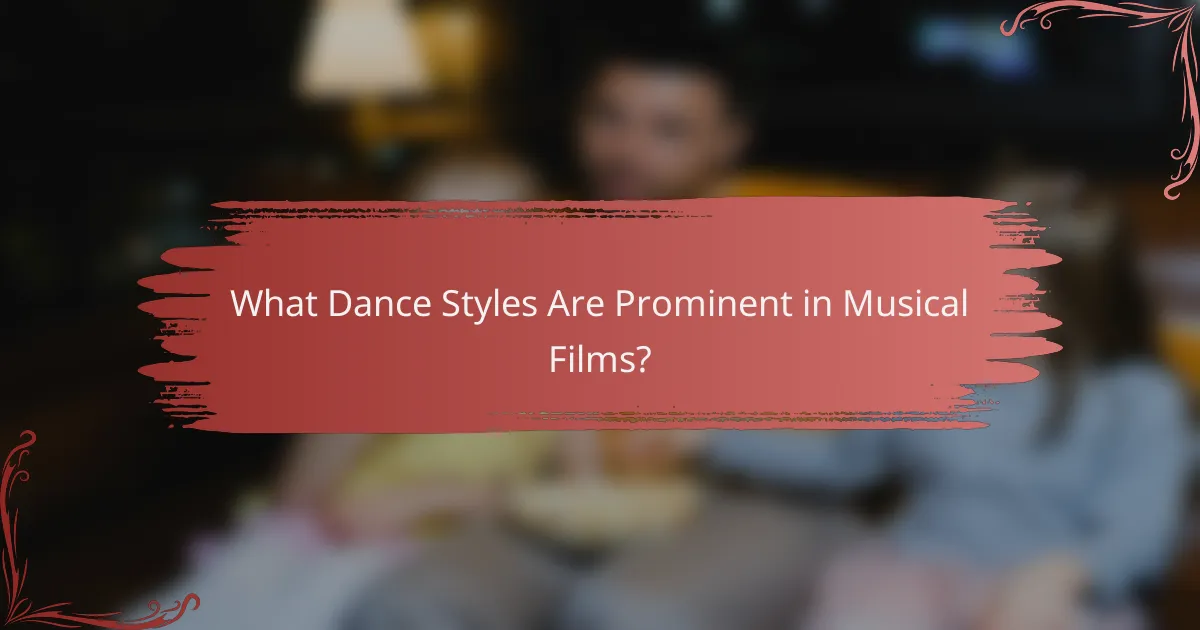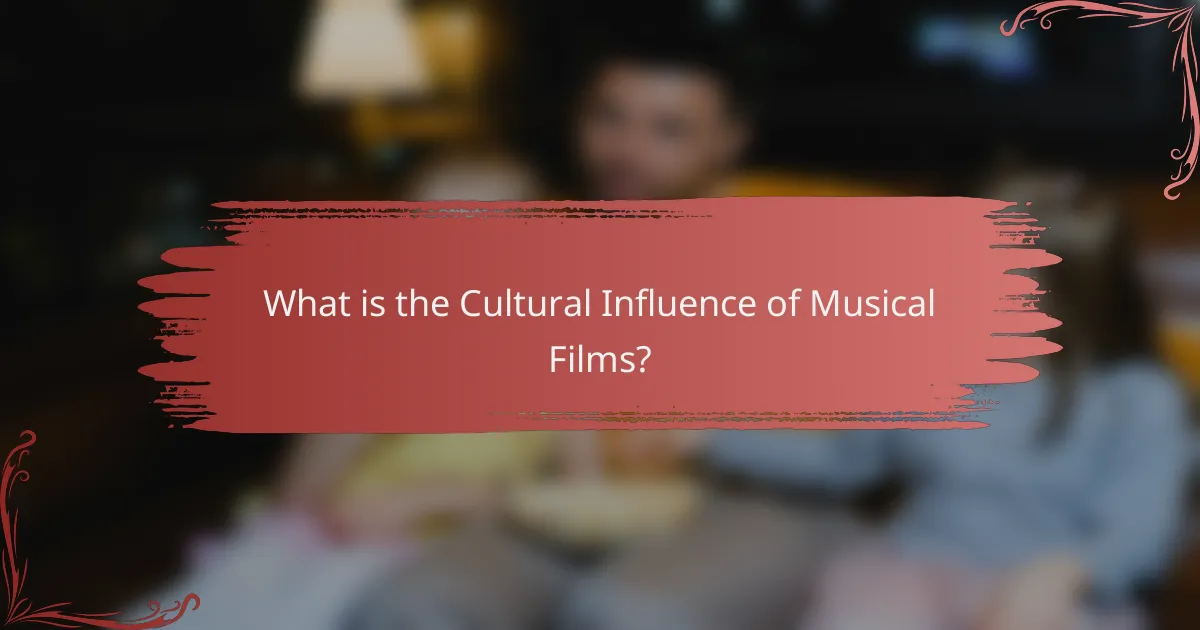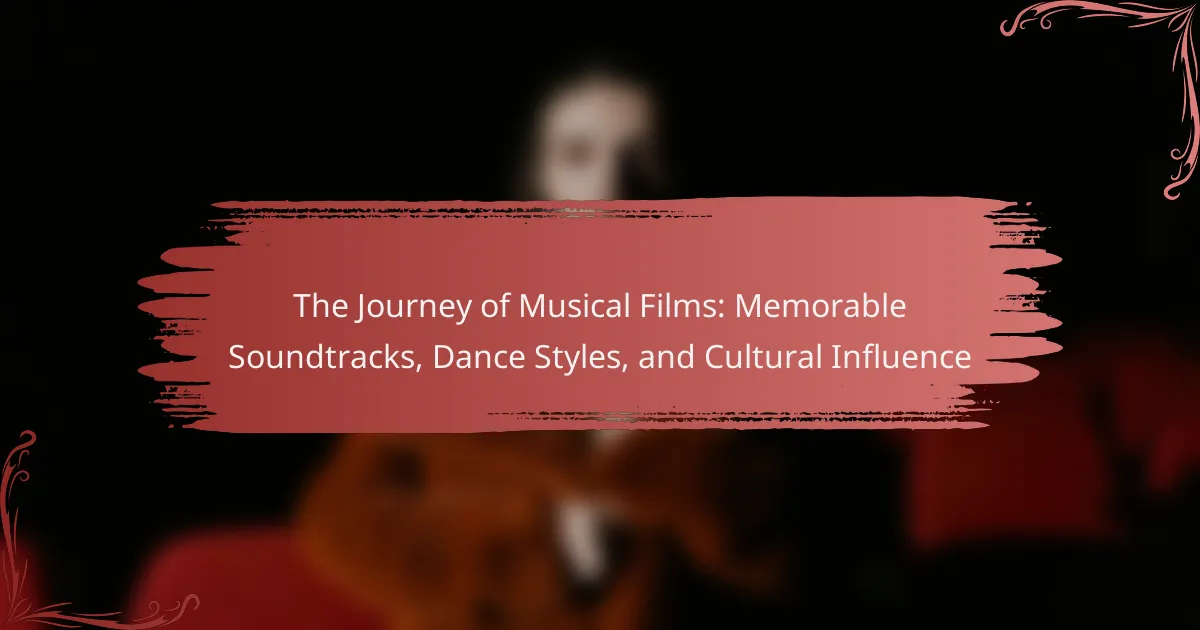Musical films are a genre of cinema that combines songs and dance with narrative storytelling, allowing characters to express emotions and progress the plot through musical numbers. This article explores the evolution of musical films, highlighting key examples from the early 20th century, such as “The Jazz Singer,” and examining their cultural significance and impact on societal norms. It also discusses prominent dance styles featured in these films, including jazz, ballet, tap, and hip-hop, and how they contribute to emotional expression and storytelling. Additionally, the article addresses the genre’s influence on cultural movements, fashion, and social issues, demonstrating its enduring legacy in global cinema.

What are Musical Films and Their Significance?
Musical films are a genre of cinema that integrates songs and dance into the narrative. They often feature characters who express their emotions and advance the plot through musical numbers. This genre gained popularity in the early 20th century, with notable examples like “The Jazz Singer” in 1927. Musical films hold cultural significance as they reflect societal values and trends. They often provide escapism through vibrant visuals and catchy soundtracks. Additionally, musicals can influence fashion, dance styles, and even language. The genre has evolved, incorporating various musical styles, from classical to contemporary pop. Their impact on film and culture remains profound, shaping audience experiences and artistic expression.
How have musical films evolved over time?
Musical films have evolved significantly since their inception in the early 20th century. Initially, silent films featured live music to enhance storytelling. The introduction of synchronized sound in the late 1920s revolutionized the genre. “The Jazz Singer,” released in 1927, marked the first successful talking musical film. During the 1930s and 1940s, lavish musicals became popular, showcasing elaborate dance numbers and star-studded casts. The Golden Age of Hollywood saw films like “Singin’ in the Rain” and “The Wizard of Oz,” which combined music and narrative seamlessly. In the 1960s and 1970s, musicals began to incorporate contemporary themes and styles, as seen in “West Side Story” and “Hair.” The late 20th century introduced rock musicals, such as “The Rocky Horror Picture Show.” Today, musicals continue to evolve, blending genres and exploring diverse cultural narratives, as evidenced by films like “La La Land” and “Hamilton.” This evolution reflects changing societal values and technological advancements in filmmaking.
What historical events influenced the development of musical films?
The development of musical films was influenced by several historical events. The advent of sound technology in the late 1920s marked a significant turning point. The release of “The Jazz Singer” in 1927 showcased synchronized sound and dialogue in film. This innovation paved the way for musicals to incorporate singing and dancing effectively.
The Great Depression in the 1930s also played a crucial role. Audiences sought escapism during tough economic times. Musical films provided uplifting entertainment, leading to the popularity of films like “42nd Street” and “Gold Diggers of 1933.”
World War II influenced musical films as well. The war effort led to the production of films that boosted morale. Musicals featuring patriotic themes, such as “This Is the Army,” became popular during this era.
The cultural shifts of the 1960s and 1970s further impacted musical films. The rise of rock and pop music led to the creation of films like “Grease” and “The Rocky Horror Picture Show.” These films reflected contemporary societal changes and musical trends.
Overall, technological advancements, economic conditions, global conflicts, and cultural movements significantly shaped the evolution of musical films.
How do musical films reflect cultural shifts in society?
Musical films reflect cultural shifts in society by showcasing evolving social norms and values. They often address contemporary issues such as race, gender, and class. For example, films like “West Side Story” highlight racial tensions and integration. Similarly, “Hairspray” addresses issues of body image and racial equality during the 1960s. The music and dance styles in these films also evolve, mirroring popular culture trends. For instance, the rise of hip-hop in the 2000s influenced musicals like “In the Heights.” Additionally, the themes in musical films can resonate with audience experiences, leading to broader societal conversations. Overall, musical films serve as a reflection and commentary on the cultural landscape of their time.
What are the key elements of a memorable musical film?
Key elements of a memorable musical film include a compelling storyline, engaging characters, and memorable music. A compelling storyline drives the narrative and connects with the audience emotionally. Engaging characters bring depth and relatability, making viewers invested in their journeys. Memorable music is essential, as it enhances emotional impact and often becomes iconic. Additionally, choreography plays a crucial role, providing visual appeal and enhancing storytelling through dance. High production values, including set design and cinematography, contribute to the overall aesthetic. Cultural relevance also enriches the film, allowing it to resonate with a broader audience. These elements combined create an unforgettable cinematic experience.
How do soundtracks enhance the storytelling in musical films?
Soundtracks enhance storytelling in musical films by providing emotional depth and context. They help convey characters’ feelings and motivations. For instance, a triumphant score can signify victory or joy. Conversely, a somber melody can evoke sadness or reflection.
Soundtracks also establish the setting and time period of the narrative. Specific musical styles can indicate cultural backgrounds or historical contexts. For example, jazz elements may highlight a 1920s setting.
Additionally, songs often advance the plot through lyrics that reveal character intentions. This technique allows for a deeper connection between the audience and the story.
Furthermore, soundtracks create memorable moments that resonate with viewers. Iconic songs can become synonymous with the film itself, enhancing its legacy.
Overall, soundtracks are integral to the narrative structure of musical films, enriching the audience’s experience.
What role do dance styles play in the appeal of musical films?
Dance styles are crucial in enhancing the appeal of musical films. They provide visual excitement and emotional expression. Iconic dance sequences often become memorable highlights of these films. For instance, “West Side Story” features innovative choreography that complements its narrative. The integration of diverse dance styles attracts broader audiences. Styles like jazz, ballet, and hip-hop resonate with different cultural backgrounds. This variety enriches the storytelling and enhances viewer engagement. Furthermore, dance serves as a powerful tool for character development and plot progression. Overall, the role of dance styles is integral to the success and lasting impact of musical films.
Why are soundtracks considered iconic in musical films?
Soundtracks are considered iconic in musical films because they enhance storytelling and evoke emotions. They often feature memorable melodies that resonate with audiences. Iconic soundtracks can define a film’s identity, making it recognizable long after its release. For example, the soundtrack of “The Sound of Music” includes songs like “Do-Re-Mi,” which have become cultural staples. Additionally, soundtracks can achieve commercial success, often topping music charts. The emotional connection established through music can lead to a lasting impact on viewers. Studies show that music can enhance memory recall, making soundtracks a vital part of the cinematic experience.
What are some examples of unforgettable soundtracks in musical history?
Some examples of unforgettable soundtracks in musical history include “The Sound of Music,” “Star Wars,” and “The Lion King.” “The Sound of Music,” composed by Richard Rodgers and Oscar Hammerstein II, features iconic songs like “Do-Re-Mi” and “My Favorite Things.” “Star Wars,” created by John Williams, is known for its memorable score, including the main title theme. “The Lion King,” with music by Elton John and lyrics by Tim Rice, includes beloved tracks such as “Circle of Life” and “Can You Feel the Love Tonight.” Each of these soundtracks has left a significant cultural impact and is recognized for its artistic contribution to film music.
How do composers create memorable musical scores for films?
Composers create memorable musical scores for films by combining thematic development, emotional resonance, and orchestration techniques. They often start with a central theme that encapsulates the film’s essence. This theme is then developed throughout the score, evolving alongside the narrative. Emotional resonance is achieved by aligning musical elements with character arcs and pivotal scenes. For instance, composers utilize dynamics, tempo, and instrumentation to evoke specific feelings. Orchestration plays a crucial role; different instruments can convey varied emotions and settings. Collaborating with directors ensures that the score complements the visual storytelling. Historical examples include John Williams’ score for “Star Wars,” which features iconic themes that enhance character identities. This approach results in scores that remain memorable and impactful for audiences.

What Dance Styles Are Prominent in Musical Films?
Prominent dance styles in musical films include jazz, ballet, tap, and hip-hop. Jazz dance is often characterized by its energetic and improvisational nature. It is frequently seen in classic musicals like “Chicago.” Ballet is known for its grace and technical precision, showcased in films like “The Red Shoes.” Tap dance features rhythmic footwork and is highlighted in movies such as “Singin’ in the Rain.” Hip-hop has gained popularity in recent musicals, reflecting contemporary culture, as seen in “Step Up.” Each style contributes uniquely to the storytelling and emotional expression in musical films.
How do different dance styles contribute to the narrative of musical films?
Different dance styles enhance the narrative of musical films by expressing emotions and advancing plotlines. Each style, such as ballet, jazz, or hip-hop, carries unique cultural significance and storytelling potential. For instance, ballet often conveys grace and elegance, reflecting characters’ inner struggles or aspirations. Jazz dance typically embodies energy and spontaneity, illustrating moments of joy or conflict. Hip-hop can represent rebellion and authenticity, aligning with contemporary themes in the storyline. Historical context shows that dance styles have evolved alongside societal changes, influencing character development and viewer engagement. Notable examples include “West Side Story,” where dance illustrates the tension between rival gangs, and “La La Land,” where dance sequences depict the characters’ dreams and desires.
What are the most popular dance styles featured in musical films?
The most popular dance styles featured in musical films include ballet, jazz, tap, and hip-hop. Ballet is often showcased for its grace and technical precision. Jazz dance brings energy and improvisation to performances. Tap dance emphasizes rhythm and sound through footwork. Hip-hop dance reflects contemporary culture and urban influences. These styles are integral to storytelling in musicals. Films like “West Side Story” highlight ballet and jazz. “Singin’ in the Rain” is famous for its tap sequences. “Hairspray” incorporates hip-hop elements. Each style contributes to the film’s emotional impact and entertainment value.
How do choreographers develop dance sequences for musical films?
Choreographers develop dance sequences for musical films by first analyzing the script and characters. They consider the emotional tone and narrative context of the film. Next, they create movement that aligns with the music’s rhythm and style. Choreographers often collaborate with directors and composers to ensure cohesion. They may conduct workshops with dancers to explore movement possibilities. Rehearsals are essential for refining the sequences. Feedback from the creative team helps in making adjustments. Successful sequences enhance storytelling and engage the audience. Historical examples include “West Side Story,” where choreography was integral to plot development.
What impact do dance styles have on audience engagement?
Dance styles significantly influence audience engagement by enhancing emotional connection and visual appeal. Different styles evoke various responses; for instance, energetic hip-hop can energize viewers, while classical ballet may inspire awe. A study by the University of California found that audiences are more likely to remember performances with dynamic choreography. Engaging dance styles can also encourage audience participation, increasing overall enjoyment. In musical films, the integration of diverse dance styles often reflects cultural themes, further deepening viewer investment. Therefore, the choice of dance style is crucial in shaping audience experiences and fostering lasting impressions.
How can dance styles evoke emotions in viewers?
Dance styles can evoke emotions in viewers through movement, rhythm, and expression. Each dance style has unique characteristics that convey specific feelings. For example, ballet often expresses grace and beauty, while hip-hop can convey energy and rebellion. The use of music in dance enhances emotional impact. The rhythm of the music influences the speed and intensity of movements. Choreography often reflects the narrative or themes of the performance. Viewers connect emotionally with dancers through visual storytelling. Studies show that dance can trigger emotional responses by activating mirror neurons in the brain. This neurological response allows audiences to empathize with the dancers’ feelings.
What are some memorable dance performances that defined musical films?
Memorable dance performances that defined musical films include “Singin’ in the Rain,” featuring Gene Kelly’s iconic rain-soaked dance. This performance showcased innovative choreography and cinematography. Another significant moment is the “Time Warp” from “The Rocky Horror Picture Show,” which became a cultural phenomenon. The choreography invited audience participation, enhancing its impact. The “Cell Block Tango” from “Chicago” highlighted the integration of dance and storytelling through its sharp movements and powerful narrative. In “West Side Story,” the “Dance at the Gym” scene exemplified the blending of ballet and street dance, influencing future musicals. Each of these performances left a lasting legacy in the genre.

What is the Cultural Influence of Musical Films?
Musical films significantly shape cultural perspectives and societal norms. They often reflect and influence prevailing social issues, such as race, gender, and class. For instance, films like “West Side Story” address racial tensions and urban life. The songs and dance styles presented can popularize specific cultural movements. The genre often promotes inclusivity by showcasing diverse talent and stories. Studies show that musical films can enhance emotional connections to cultural narratives. The success of musicals can lead to a resurgence in interest in particular music genres. Historical context, such as the impact of the Hollywood Golden Age, illustrates their lasting influence on global cinema.
How do musical films shape cultural perceptions and identities?
Musical films shape cultural perceptions and identities by reflecting societal values and norms. They often depict diverse cultures and traditions through music and dance. This representation can influence audience perceptions of those cultures. For instance, films like “West Side Story” highlight issues of race and identity. They can challenge stereotypes and promote understanding. Additionally, memorable soundtracks can create emotional connections to cultural narratives. Research shows that musical films can impact viewers’ attitudes toward social issues. Studies indicate that exposure to diverse musical genres in films enhances cultural appreciation. Thus, musical films play a significant role in shaping cultural identities and perceptions.
What themes in musical films resonate with diverse audiences?
Themes in musical films that resonate with diverse audiences include love, struggle, and self-discovery. Love stories often transcend cultural barriers, appealing universally. Struggles against adversity reflect shared human experiences, fostering connection. Self-discovery journeys resonate as individuals seek their identity and purpose. These themes are often portrayed through relatable characters and engaging narratives. For example, films like “The Greatest Showman” explore ambition and acceptance, attracting varied viewers. Additionally, the use of music and dance enhances emotional engagement, making themes more impactful. Studies show that emotional storytelling in musicals can lead to increased audience empathy and connection.
How have musical films influenced other art forms and media?
Musical films have significantly influenced other art forms and media. They have integrated music, dance, and storytelling in a unique way. This fusion has inspired theatrical productions to incorporate similar elements. Broadway musicals often draw from successful film adaptations. The visual style of musical films has impacted television shows, leading to musical episodes in series. Animated films have also adopted musical formats, enhancing storytelling through song. Additionally, music videos have evolved from musical film influences, focusing on choreography and narrative. The popularity of musical films has led to increased collaboration between filmmakers and musicians. These interactions have shaped genres and trends in contemporary media.
Why is the legacy of musical films important in contemporary culture?
The legacy of musical films is important in contemporary culture because they shape artistic expression and community identity. These films blend storytelling with music and dance, creating a unique form of entertainment. They influence various genres, inspiring modern filmmakers and musicians. Iconic musicals like “West Side Story” and “The Sound of Music” continue to resonate today. Their themes often address social issues, promoting dialogue and reflection. Additionally, memorable soundtracks from these films are frequently revisited and celebrated. This ongoing appreciation highlights their cultural significance and impact.
How do modern musical films pay homage to classic musicals?
Modern musical films pay homage to classic musicals through various stylistic and thematic elements. They often incorporate iconic songs from earlier works. This practice connects contemporary audiences to the rich history of musicals. Additionally, modern films replicate classic choreography styles, showcasing the evolution of dance. They frequently reference famous scenes or visual motifs from past musicals. For instance, films like “La La Land” pay tribute to “Singin’ in the Rain” through similar cinematography. Furthermore, modern musicals explore themes of nostalgia and the passage of time. This approach resonates with audiences familiar with classic narratives. Overall, these methods create a bridge between old and new, celebrating the legacy of musical cinema.
What lessons can be learned from the cultural impact of musical films?
Musical films illustrate the power of storytelling through music and dance. They often reflect societal values and cultural shifts. For example, “West Side Story” addressed racial tensions in the 1960s. The integration of diverse musical styles fosters cultural appreciation and understanding. Films like “The Sound of Music” promote themes of family and resilience. They also serve as a historical record of the era’s social issues. Musical films can inspire social movements, as seen with “Hamilton,” which highlights American history through a modern lens. Overall, they teach the importance of creativity in addressing complex cultural narratives.
What are some best practices for appreciating musical films?
To appreciate musical films effectively, immerse yourself in the storyline and music. Focus on how the music enhances the emotional depth of the narrative. Pay attention to the choreography and its connection to the plot. Analyze the cultural context that influences the film’s themes and styles. Engage with the performances, noting the actors’ vocal and acting skills. Consider the historical significance of the musical genre represented. Discuss the film with others to gain diverse perspectives. Lastly, watch multiple examples within the genre to understand its evolution and variations.
How can viewers enhance their experience when watching musical films?
Viewers can enhance their experience when watching musical films by actively engaging with the music and choreography. Listening to the soundtrack before viewing can create anticipation. Familiarity with songs helps viewers appreciate the performances more deeply. Participating in sing-alongs can increase enjoyment and immersion. Discussing the film with others can provide new insights and perspectives. Watching with subtitles can improve understanding of lyrics and themes. Research shows that audience engagement boosts emotional connection to the film. Engaging with behind-the-scenes content can enhance appreciation for the artistry involved.
What resources are available for exploring the history of musical films?
Books on musical films provide in-depth analysis and historical context. “The Musical: A Concise History” by Kurt Ganzl is a notable resource. Academic journals offer scholarly articles on the evolution of musical cinema. The “Journal of Film and Video” often features relevant studies. Online databases like JSTOR provide access to historical film research. Documentaries, such as “That’s Entertainment!” showcase iconic musical moments. Film archives, like the Library of Congress, preserve original musical film materials. Websites dedicated to film history, such as Turner Classic Movies, provide curated content on musicals.
Musical films are a genre that combines songs and dance with narrative storytelling, reflecting cultural values and societal trends. This article explores the evolution of musical films, highlighting significant historical events that shaped the genre and how they mirror cultural shifts. Key elements of memorable musicals, including soundtracks and dance styles, are examined for their role in enhancing storytelling and audience engagement. Additionally, the article discusses the cultural influence of musical films, their legacy in contemporary society, and best practices for appreciating this cinematic art form.
